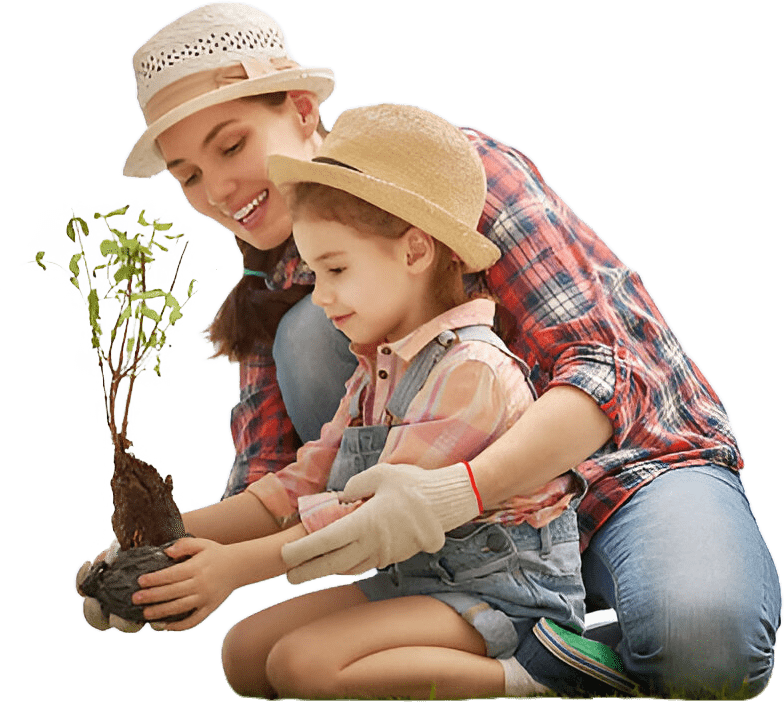Springtime marks new beginnings and growth; however, not all growth is welcome, especially fungal diseases that may destroy your trees. The cool, moist weather of early spring days, like the weather the Northern VA, DC Metro area has already been experiencing this spring, creates the perfect breeding ground for fungal diseases.
In this article, we discuss the 6 fungal diseases you need to watch out for and begin proactively acting against this May. After all, once fungus starts attacking your trees, there is no going back.
Why We See More Fungal Diseases in Spring
If there are two things that fungi love, it’s cool weather and moisture! Spring is the ideal combination of warmth – without being too hot – and humidity, which is the perfect recipe for fungi to develop and spread! High relative humidity is crucial to germinating spores and budding, through which fungi reproduce. April showers will bring May fungus! So, while we crank up the air conditioning to escape the humid outdoors, fungi are gearing up to feast!
The Consequences of Untreated Fungus on Trees
Fungi are a tricky infection. While they may not quickly kill your tree, if left untreated they will weaken your tree, making it susceptible to even worse diseases and pests. The biggest factor is how fungi coat plants. They smother leaves, cutting off the plant’s ability to absorb sunlight and photosynthesize. Ultimately, some plants can die from fungi alone.
Of course, there are exceptions to this. Not all fungi are harmful! Some fungi are indicators that a tree is declining – but they are not the reason for the decline. These fungi merely make their appearance as faithful decomposers after a tree is on its way out. One harmless fungus that we see in often is lichen on trees. These patches of fungus on tree trunks are harmless, but can be concerning if you aren’t familiar with them! Knowing which fungi are harmful will save you the headache, and can save your trees!
The Most Common Spring Fungal Diseases in the DC Metro Area
1. Anthracnose
The main culprit behind anthracnose diseases is excess water. Due to the rainy weather and tree watering in the spring, trees in our area become prone to fungal disease.
If left untreated, the trees will become susceptible to secondary invaders. This ultimately impacts their long-term health.
Symptoms:
- Younger leaves will likely appear misshapen (curled, distorted) with brown spots.
- Mature leaves tend to have dark brown spots on normal-shaped leaves but may have signs of pest damage.
- Symptoms may disappear during a dry spell but come back during or after a rainstorm.
Targets: Dogwood, Ash, Oak, Sycamore, Birch, Walnut, Tulip, Hickory, and Maple trees
In the spring, our Certified Arborists see a ton of Dogwood Anthracnose. If you have a dogwood (except for Kousa Dogwoods), your tree should be on a preventative spray treatment this spring!
Learn more about Anthracnose
2. Sooty Mold
Sooty mold coats tree leaves which can indirectly impact the tree’s health. This coating restricts the tree’s ability to absorb sunlight and interferes with its ability to photosynthesize and produce nutrients. Without its needed nutrients, the tree is unlikely to survive. It is also an indication that there is an underlying pest problem!
Sooty mold doesn’t occur on its own. It is the result of honeydew accumulation on plant surfaces. Honeydew is an excretion from pests such as aphids and scale.
Symptoms:
- Black mold coating leaves and nearby plants.
- Stunted tree growth.
- Early defoliation or leaf drop.
- Tree bugs (lace bugs, scale insects, aphids) suck up sap from the tree.
- Honeydew residue dripping from the plant.
Targets: Rose, Ash, Oak, Elm, Maples, Willow, and fruit trees
Learn more about Sooty Mold
3. Powdery Mildew
Similar to sooty mold, powdery mildew coats leaves, which results in the tree not receiving the nutrients it needs to survive. The tree becomes unable to create food, which stunts the plant’s growth altogether. Long-term, the tree becomes stressed and more susceptible to other diseases or pest infestations.
Typically, powdery mildew is carried by the wind from an infected plant to a healthy plant.
Symptoms:
- White to grayish spots or patches on leaves.
- Leaves dry out and turn yellow or appear scorched. They may also twist or break.
Targets: Lilac, Peony, Dogwood, and Crape Myrtle trees.
Learn more about Powdery Mildew
4. Leaf Spot
The typical wet, warm conditions of spring lead to Cercospora leaf spot disease in tree leaves. Symptoms of leaf spot fungal disease may start as a small spot on the leaf, but as the disease spreads, the spots become more rampant throughout the foliage. As a result, the tree’s leaves stop doing their job and fall off the tree. Due to the frequent defoliation, the tree’s health will decline.
Symptoms:
- Round leaf spots, potentially with purple or dark brown borders
- Tiny black specks, representing fungal spores, at the center of these leaf spots
Targets: It can affect various species of ornamentals and shade trees, but white oak trees are the most prevalently affected in our area.
Learn more about Cercospora Leaf Spot
5. Phytophthora Root Rot
Generally, phytophthora root rot develops when the soil around the tree’s base remains wet for a long time.
This disease impacts the tree’s root systems, diminishes the tree’s structural integrity, and can lead to additional issues such as property damage and injury. Usually, it won’t immediately lead to tree death, but it will if the tree is left untreated for years.
Symptoms:
- Darkened bark
- Suppressed tree growth
- Yellowing or browning leaves
- Unusually small leaves
- Branch dieback
- Drooping and curling of tree leaves
Targets: Most commonly azalea, rhododendron, dogwood, pieris, yew bushes, deodar cedar, mountain laurel, heather, juniper, Fraser fir, white pine, shortleaf pine, camellia japonica, aucuba.
Learn more about Phytophthora Root Rot
6. Shot-hole Fungus

This tree fungus is commonly mistaken for insect damage because it leaves BB-sized holes in the foliage. This fungus will stress your plants and should be treated to keep secondary invaders away.
Symptoms:
- Brown or reddish-brown leaf spots
- Holes in leaves where the leaf spots used to be
- Yellow leaves dropping in mid-summer
Targets: Cherries, Cherry Laurels, Roses
Learn more about Shot-hole Fungus.
How Can You Treat Fungal Diseases on Trees?
The best treatment for fungal tree disease is preventative treatment through spray applications. At RTEC, we have crafted the perfect regime of Intensive Treatments to keep fungi at bay. If you are looking for a more comprehensive program, our Canopy Protection Program ensures that one of our highly trained technicians is on your property year-round to treat and prevent fungi from attacking your plants!
With that said, if you notice your tree already suffering from a fungal disease, it’s crucial to act on it right now to make sure the fungal tree disease doesn’t return next year. Through treatments and pruning out diseased branches, you can restore your tree’s health. If your plants are already infected, RTEC offers treatments to control and suppress harmful fungi! Ideally, we will be there to help you take these preventative steps so it never becomes an issue.
The Best Ways to Prevent Fungal Tree Diseases
There are other preventative actions you can take to reduce the chance of fungual development.
- Correctly watering your trees and making sure your soil drains properly. The soil should be moist (some dry patches are okay) but it shouldn’t be so wet you could make a mud ball.
- Our Certified Arborists have observed the importance of not overwatering your trees, especially during the spring. Most irrigation systems don’t need to be turned on around this time of the year. You can hold off on turning them on until the weather gets hotter and drier.
- Keep your trees healthy overall. Bio-stimulants and proper pruning can boost your tree’s immune system which lowers the likelihood of infection after being exposed to fungal diseases.
- In the fall, rake all leaves and dispose of them. This will keep fungal spores in those leaves from reinfecting plants in the spring.
- Prune regularly. Cleaning out shrubs and canopies regularly will allow for proper airflow, letting plants dry thoroughly.
- Water roots, not leaves! Wetting leaves can encourage fungal growth and has no real benefit to the plants. So, ensure the water goes into the soil where the roots can drink it up!







